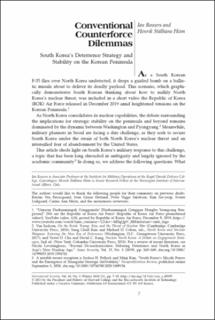| dc.contributor.author | Hiim, Henrik Stålhane | |
| dc.contributor.author | Bowers, Ian | |
| dc.date.accessioned | 2021-03-19T12:52:39Z | |
| dc.date.available | 2021-03-19T12:52:39Z | |
| dc.date.created | 2021-02-05T18:23:51Z | |
| dc.date.issued | 2021 | |
| dc.identifier.citation | International Security. 2021, 45 (3), 7-39. | en_US |
| dc.identifier.issn | 0162-2889 | |
| dc.identifier.uri | https://hdl.handle.net/11250/2734505 | |
| dc.description.abstract | In response to North Korea's nuclear weapons program, South Korea is quietly pursuing an independent conventional counterforce and countervalue strategy. This strategy is unique. Few, if any, nonnuclear states have sought to rely on advanced conventional capabilities to deter a nuclear-armed adversary. Why is South Korea pursuing a conventional counterforce and countervalue strategy, and what could its impact be on strategic stability on the Korean Peninsula? South Korea's approach should be understood as both a short- and long-term hedge against U.S. abandonment. Its deterrent effect, no matter how uncertain, acts as a short-term stopgap if the United States abandons South Korea. Over the long term, capabilities such as advanced ballistic and cruise missiles bolster South Korea's nuclear latency. At the same time, we highlight that the strategy poses numerous technological and operational difficulties and has negative implications for arms race and crisis stability. Given South Korea's approach and North Korea's response, disarmament efforts focused purely on the bilateral U.S.–North Korea relationship will not succeed. Rather, any agreement will now need to address the growing gap in the conventional balance of forces on the Korean Peninsula. | |
| dc.language.iso | eng | en_US |
| dc.rights | Navngivelse 4.0 Internasjonal | * |
| dc.rights.uri | http://creativecommons.org/licenses/by/4.0/deed.no | * |
| dc.subject | Forsvar | |
| dc.subject | Defence | |
| dc.subject | Sikkerhetspolitikk | |
| dc.subject | Security policies | |
| dc.subject | Asia | |
| dc.subject | Asia | |
| dc.title | Conventional Counterforce Dilemmas: South Korea's Deterrence Strategy and Stability on the Korean Peninsula | en_US |
| dc.type | Peer reviewed | en_US |
| dc.type | Journal article | en_US |
| dc.description.version | publishedVersion | |
| dc.subject.nsi | VDP::Internasjonal politikk: 243 | |
| dc.subject.nsi | VDP::International politics: 243 | |
| dc.source.pagenumber | 7-39 | en_US |
| dc.source.volume | 45 | en_US |
| dc.source.journal | International Security | en_US |
| dc.source.issue | 3 | en_US |
| dc.identifier.doi | 10.1162/isec_a_00399 | |
| dc.identifier.cristin | 1887217 | |
| cristin.ispublished | true | |
| cristin.fulltext | original | |
| cristin.qualitycode | 2 | |

